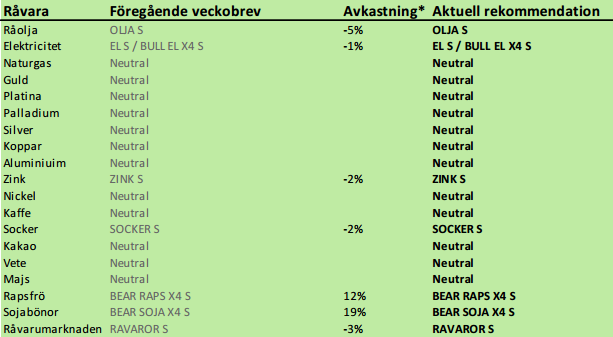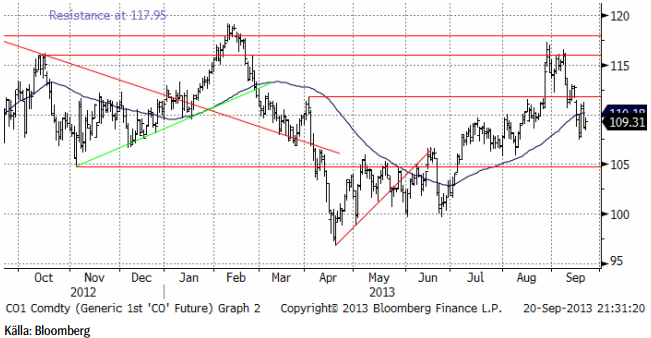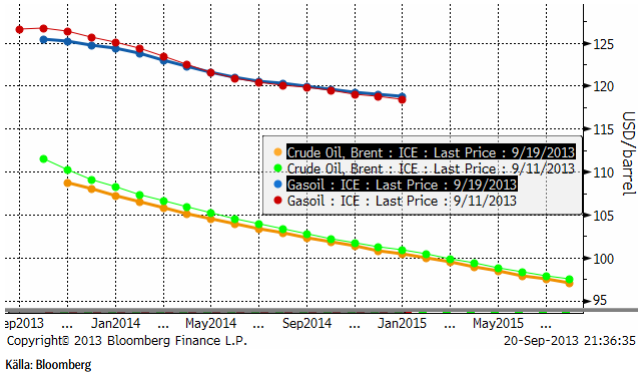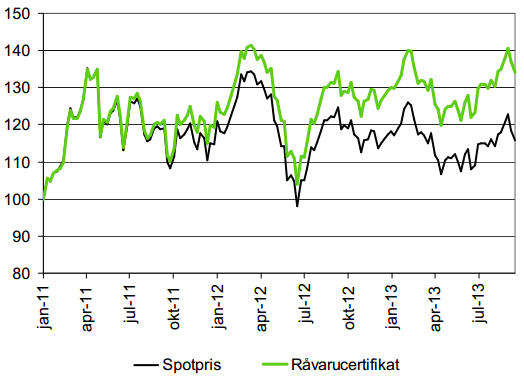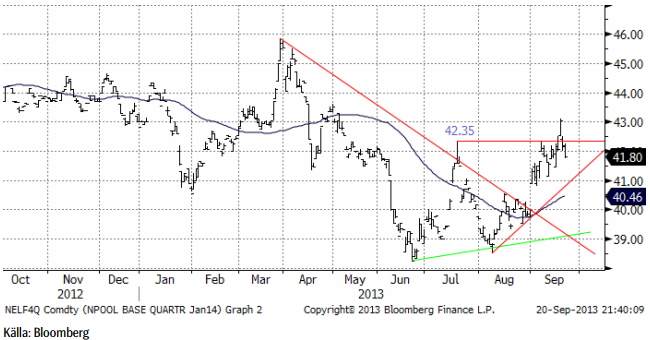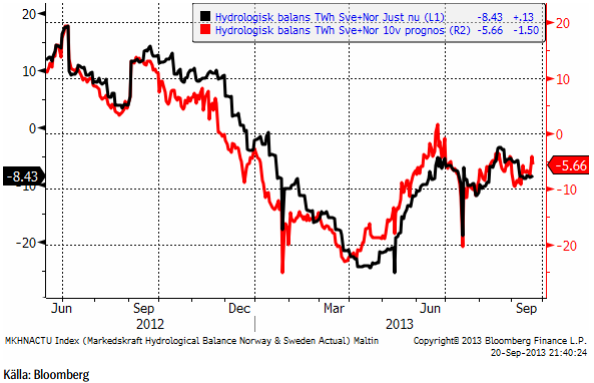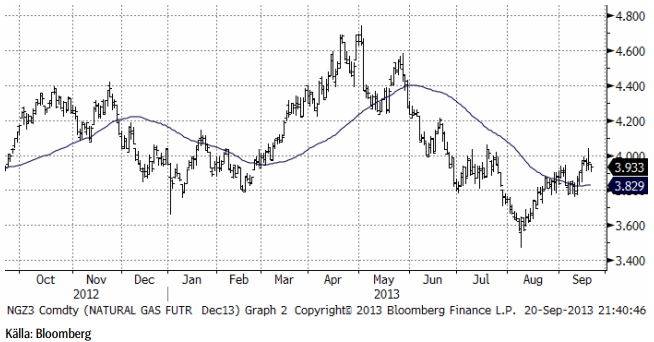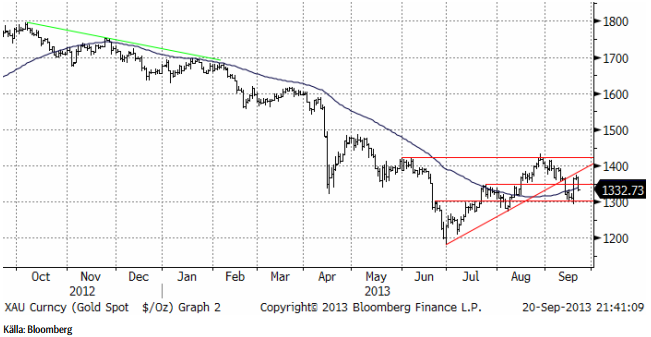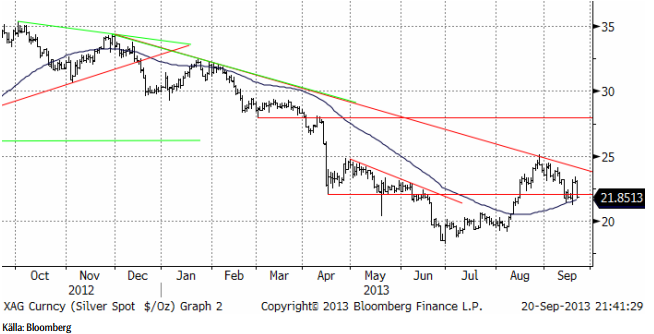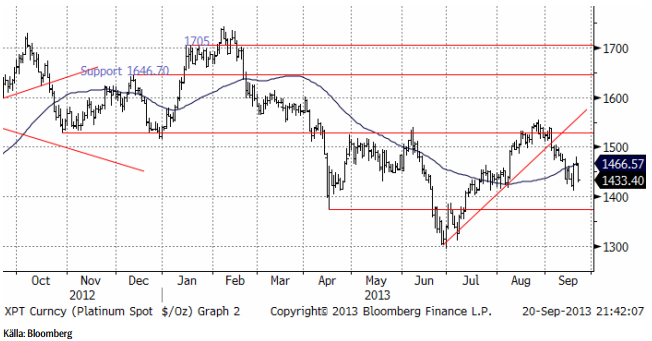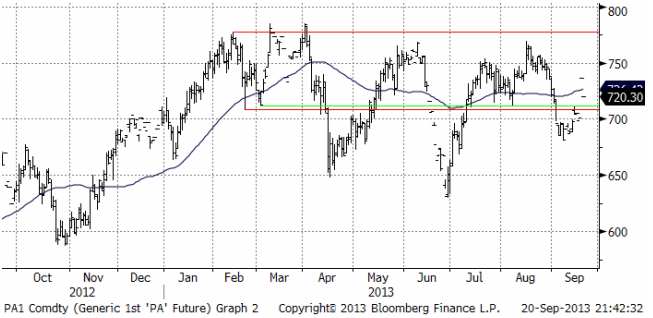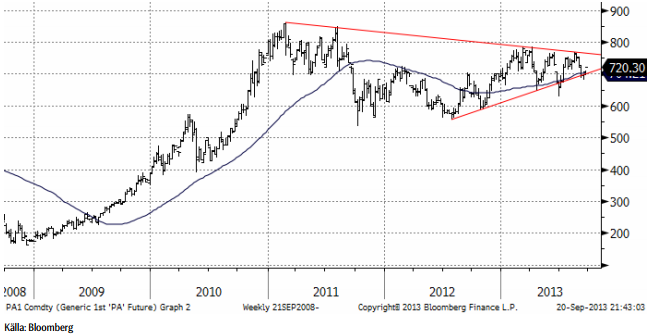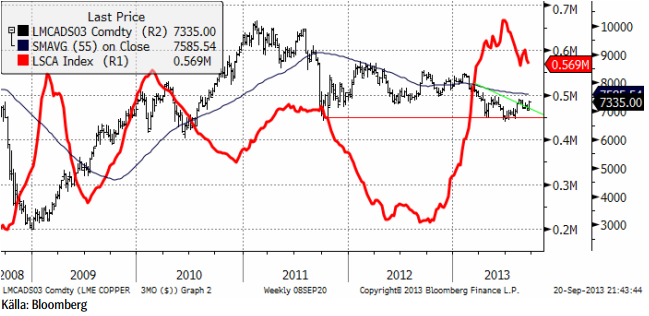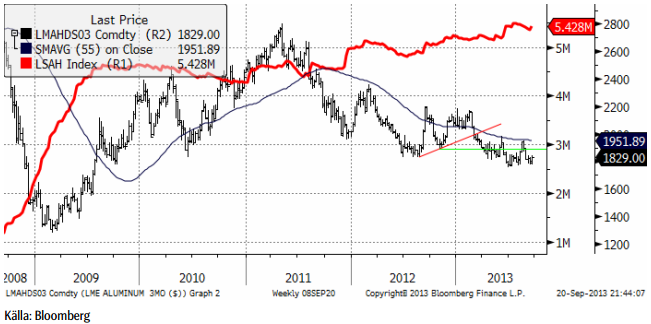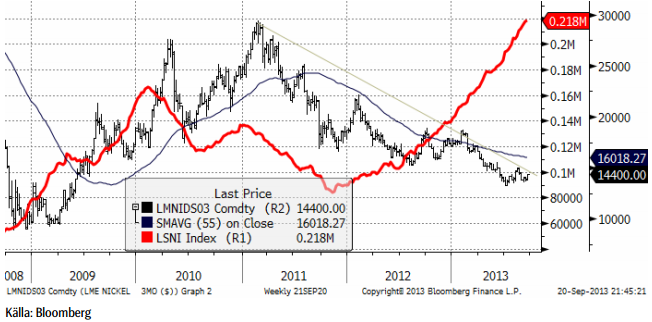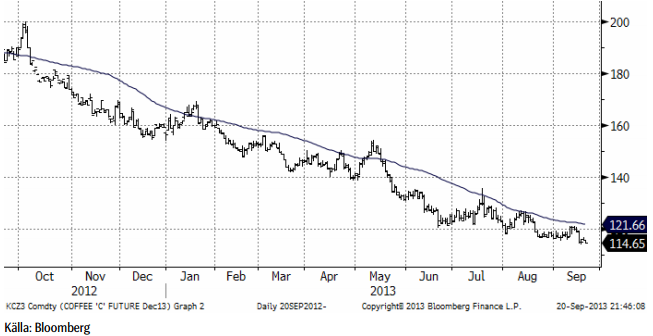Analys
SEB – Råvarukommentarer, 23 september 2013

Rekommendationer
*) Avkastningen anges för 1:1 certifikaten där både BULL och 1:1 certifikat är angivna.
Inledning
Prisrörelserna förra veckan påverkades mycket av den amerikanska centralbanken. Först kom beskedet att det inte blir någon minskning i centralbankens (FED:s) köp av amerikanska obligationer, förrän tidigast år 2015. Anledningen är att man inte sett tillräcklig effekt på ekonomin än av de köp (och utbetalningar av pengar) som skett. Man kan fråga sig var de läst att sedelpressen någonsin skapat sysselsättning. Beslutet fick alla råvarumarknader att hoppa upp. Råvarulandet Brasliens aktiebörs blev den bästa av nästan 100 aktiebörser i världen, den dagen. I fredags gjorde så en medlem i FED ett uttalande som antydde att det ändå kan bli fråga om minskning i centralbankens återköp. Analytiker tolkade detta som en del i FED:s kommunikationsstrategi. Marknaderna föll abrupt på detta sent på fredagen. Jag ser dock detta inte som en medveten kommunikationsstrategi utan som ett tecken på oenighet i FED om fortsatt pengaproduktion är rätt väg. Det viktiga är dock att de som tycker att sedelpressen ska stå på är i majoritet och att dissidenterna är få. Vid det senaste FED-beslutet var det endast en person som var emot en förlängning till 2015. Kanske har marknaden kommit fram till samma slutsats under helgen. I så fall skulle priserna kunna gå upp i veckan som kommer.
Inga tekniska stödnivåer bröts i under fredagens prisfall – utom för sojabönor – men ”it had it coming”. Vår position i BEAR SOJA X4 S ökade i pris med 19% i veckan. Vi är fortsatt negativa till sojabönor och raps, men neutrala till spannmål och vi har köp på socker, samt köp på el och zink. Generellt sett är det, som en kollega i branschen uttryckte det i fredags, ett gyllene läge för råvaror som placering.
I torsdags var vi på Copenhagen Grain Exchange, som besöktes av rekordmånga från branschen. När man talade med folk var den allmänna bedömningen att priset på spannmål kommer att hålla sig stabilt på den här nivån åtminstone fram till våren. Det är i sig ett observandum, att man tror att volatiliteten kommer att vara låg och att priserna kommer att vara låga. Det finns inget som tyder på det, men skulle det komma nyheter som indikerar högre priser, finns ingen psykologisk förberedelse på detta.
Råolja – Brent
Oljepriset fortsatte att rekylera nedåt och gick även igenom den psykologiskt viktiga 110-dollarsnivån. Vi tycker att detta gör olja än mer köpvärt. Det är rabatten på terminerna som gör att vi vill vara investerade i olja.
Terminskurvorna för Brent (den lägre) och gasolja (mer eller mindre detsamma som diesel) ligger något lägre jämfört med förra veckan. Men notera att medan terminskurvan för brent fallit för alla löptider, har kurvan för gasolja faktiskt vridit sig, så att de längre terminskontrakten ligger högre än förra veckan. Det är också väsentligt lägre grad av backwardation i gasoljekurvan än i oljekurvan. Man får bättre betalt för att vara investerad i olja än i gasolja.
Nedan ser vi hur 100 dollar i början av januari 2011 utvecklat sig om man investerat i fysisk råolja (svart linje) eller via terminer (grön linje). På grund av rabatten på terminerna, har mer än hälften av de ca 35% avkastning under dessa två år kommit från dem – och inte från prisförändring på fysisk råolja.
För råvaruinvesterare är den här rabatten nu väldigt attraktiv. Man kan tjäna ca 7 – 10% extra på att äga råoljeterminer.
När nu priset fallit tillbaka och rabatten på terminer är så attraktiv, tycker vi att det är ett bra tillfälle att komma in i den lönsamma oljemarknaden och rekommenderar köp av OLJA S. Det är framförallt rabatten på terminerna vi vill komma åt och därför föredrar vi OLJA S framför t ex BULL OLJA X4 S.
Elektricitet
Elpriset gick i veckan över motståndet på 42.35 och vi har nu en teknisk köpsignal på el. Vi skulle dock inte bli förvånade om det kom en rekyl nedåt, efter den snabba prisuppgång som varit. En sådan rekyl nedåt ser vi som ett utmärkt köptillfälle.
Hydrologisk balans visar inge större förändringar i veckan. 10-veckors-prognosen visar på ett marginellt mindre underskott än förra veckan.
Vi rekommenderar köp av el, t ex EL S eller BULL EL X4 S.
Naturgas
Naturgaspriset studsade var uppe vid 4 dollar, en nivå som tidigare varit ett motstånd.
Vi har neutral rekommendation.
Guld & Silver
Guldpriset fann stöd på 1300 dollar och rusade uppåt på FED-beskedet om fortsatt penningpolitisk stimulans åtminstone till år 2015. Detta vände till panikförsäljning i fredags när marknaden tolkade uttalandet från St. Louis-FED:s chef som att det nog ändå kunde bli frågan om en minskning av obligationsköpen innan 2015. Den tekniska bilden indikerar att lägre pris är att vänta, men vi har ingen säljsignal än, bara en bruten uppgång.
Nedan ser vi kursdiagrammet för silver i dollar per troy ounce. Tekniskt ser marknaden faktiskt lite mer positiv ut än guld. Den fallande trenden är dock inte bruten och vi skulle inte vilja köpa så länge detta inte har skett.
Vi fortsätter att vara neutrala guld och silver och skulle inte vilja köpa någon av dem idag.
Platina & Palladium
Prisuppgången i platina hindrades vid 55-dagars glidande medelvärde. Tekniskt ser platina svagare ut än både silver och guld. Det är många som hoppas på att platina och palladium ska gå bättre än guld och silver, därför att de också har ett industriellt invändningsområde i katalysatorer. Det innebär att det finns mycket förhoppningar investerat redan i metallerna och egentligen, en ganska stor nedsida.
Nedan ser vi frontmånadskontraktet på palladium. Palladium är en ganska illikvid metall och vi ser att priset steg kraftigt i veckan och sedan föll tillbaka.
Palladiumpriset är tillbaka i den triangelformation vi talat om tidigare.
Vi är för närvarande neutrala platina och palladium, men om palladium skulle falla bara något lite ytterligare, skulle vi vilja haka på och ta en kort position via BEAR PALLAD X4 S. Vi skulle absolut inte vilja köpa någon av dem.
Koppar
Koppar var den basmetall som gick bäst i veckan med en uppgång på 2.5%, trots den generella svagheten på fredagen. Tekniskt bröts den kortsiktiga nedåttrenden i torsdags. SEB:s tekniska analytiker gjorde följande bedömning på fredagen: “Rechecking $+7,400 before down… There is some near-term momentum in the ongoing move higher, as it was able to gap through short-term resistance at ≈7,200 (now likely support). This behavior puts the Aug high of 7,420 in focus, but extension beyond this level should be restricted to the 233day moving average band (7,445\7,575)”.
Den fysiska marknaden rapporteras vara i någorlunda balans. Arbitraget mellan SHFE och LME fanns förra veckan (Shanghai 200 dollar högre). Lagren på LME har fallit ytterligare 2.2% i veckan.
Det ser positivt ut, men uppsidan är begränsad, enligt den tekniska analysen. Vi fortsätter därför att ha en neutral position.
Aluminium
Aluminiumprisets relativa svaghet var tydlig i veckan. Vi rekommenderar att man försöker köpa BEAR ALU X4 S på rekyler (uppåt).
Den oberoende analysfirman Wood Mackenzie publicerade en rapport i veckan som gick, som utmålade en mörk framtid för aluminiummarknaden de kommande åren. De förutspår ett överskott nästa år på 1.1 mt. Det är en rejäl ökning av överproduktionen om man jämför med årets 0.5 mt. Kina behöver stänga produktion på 1.6 mt för att regionen ska komma i balans, enligt rapporten. Det råder samstämmighet bland bedömare att marknaden behöver stora produktionsneddragningar. Den här rapporten pekar på att detta kan ta längre tid än de flesta hoppats.
Vi har neutral rekommendation, men tycker man ska försöka komma in i BEAR ALU X4 S på rekyler uppåt.
Zink
Som vi har noterat tidigare, håller zink-balansen (utbud/efterfrågan) på att förbättras. ILZG rapporterade siffrorna för juli och de visade ett litet överskott. Produktionen av raffinerad zink var 1.109 mt i juli och efterfrågan var 1.095. Detta tog bort optimismen och gav baissarna ammunition. Men faktum är att trenden går mot ett underskott. Det tar naturligtvis tid att beta av de uppkomna lagren, men det ligger i priserna. De flesta som följer marknaden är överens om att gruvkapacitet kommer att stängas nästa år, och att ny kapacitet inte kommer att kompensera detta. Det finns en stor möjlighet till stora underskott framöver. Detta kommer att ge marknaden stöd enligt vårt sätt att se. Samtidigt verkar ekonomierna i Kina, USA och Europa ta fart och den effekten på underskottet måste också beaktas.
Zink blev en besvikelse den här veckan efter den oväntade svagheten i fredags och stängde ner 0.5% på veckan.
Vi fortsätter med en försiktig köprekommendation, av ZINK S.
Nickel
Nickel är traditionellt den mest volatila av metallerna som handlas på LME och den levde upp till sitt rykte den här veckan. FEDbeskedet fick priset att stiga från 13900 dollar till 14400. Detta vändes sedan i dramatiskt prisfall på fredagskvällen och veckan stängde bara precis över 14000 dollar. De stora och stigande lager hänger hotfullt över marknaden, men vi märker av mer intressen att köpa metallen från industrin. Med tanke på vad den tekniska analysen säger, tror vi det finns möjligheter för priset att nå 15000 dollar inom överskådlig tid. Nyhetsflödet kring Indonesiens export av järnmalm med nickelinnehåll för tillverkning av Nickel Pig Iron i Kina kommer att spela en central roll och vara en källa till volatilitet i marknaden.
Kaffe
Den fallande trenden i kaffepriset tog ett nytt trappsteg ner i veckan som gick. Den här nedgången är den längsta i tid sedan 1993.
Regn i Brasilien har fått kaffeträden att sätta blomknoppar för en andra blomning. Dessa blommor kommer sedan att bli bönor. Den kommande skörden är den växelvis större. Den skörd som just bärgats var ett mellanår. Arabica är en varannanårsgröda.
Brasilianska bönor av ”good cup” kvalitet (även kallad ”Swedish quality”, faktiskt) handlades till 18 till 21 cents rabatt till noteringen på ICE i New York. ”Fine cup” kvalitet handlas till en rabatt på 13 cent enligt företaget Flavour Coffee i Rio de Janeiro.
Flavour Coffee rapporterade också att Conillons, som den brasilianska robustan kallas, handlas till 8 cents premium över LIFFE:s terminspris i London, en uppgång från förra veckans premium på 5 cent. Det fanns även vissa kvaliteter av robusta som var dyrare än arabica. Robusta odlas mest i Afrika och i Asien, där Vietnam har blivit den största producenten. Robusta används mest i snabbkaffe.
Brasilien kommer att bärga en rekordskörd, av allt att döma och globala lager ökade med över 7% i augusti enligt tradinghuset FC Stone.
Vi behåller tills vidare neutral rekommendation, tills vi ser tecken på ett trendbrott.
Fler analyser på jordbruksråvaror från SEB.
[box]SEB Veckobrev Veckans råvarukommentar är producerat av SEB Merchant Banking och publiceras i samarbete och med tillstånd på Råvarumarknaden.se[/box]
Disclaimer
The information in this document has been compiled by SEB Merchant Banking, a division within Skandinaviska Enskilda Banken AB (publ) (“SEB”).
Opinions contained in this report represent the bank’s present opinion only and are subject to change without notice. All information contained in this report has been compiled in good faith from sources believed to be reliable. However, no representation or warranty, expressed or implied, is made with respect to the completeness or accuracy of its contents and the information is not to be relied upon as authoritative. Anyone considering taking actions based upon the content of this document is urged to base his or her investment decisions upon such investigations as he or she deems necessary. This document is being provided as information only, and no specific actions are being solicited as a result of it; to the extent permitted by law, no liability whatsoever is accepted for any direct or consequential loss arising from use of this document or its contents.
About SEB
SEB is a public company incorporated in Stockholm, Sweden, with limited liability. It is a participant at major Nordic and other European Regulated Markets and Multilateral Trading Facilities (as well as some non-European equivalent markets) for trading in financial instruments, such as markets operated by NASDAQ OMX, NYSE Euronext, London Stock Exchange, Deutsche Börse, Swiss Exchanges, Turquoise and Chi-X. SEB is authorized and regulated by Finansinspektionen in Sweden; it is authorized and subject to limited regulation by the Financial Services Authority for the conduct of designated investment business in the UK, and is subject to the provisions of relevant regulators in all other jurisdictions where SEB conducts operations. SEB Merchant Banking. All rights reserved.
Analys
Tightening fundamentals – bullish inventories from DOE

The latest weekly report from the US DOE showed a substantial drawdown across key petroleum categories, adding more upside potential to the fundamental picture.

Commercial crude inventories (excl. SPR) fell by 5.8 million barrels, bringing total inventories down to 415.1 million barrels. Now sitting 11% below the five-year seasonal norm and placed in the lowest 2015-2022 range (see picture below).
Product inventories also tightened further last week. Gasoline inventories declined by 2.1 million barrels, with reductions seen in both finished gasoline and blending components. Current gasoline levels are about 3% below the five-year average for this time of year.
Among products, the most notable move came in diesel, where inventories dropped by almost 4.1 million barrels, deepening the deficit to around 20% below seasonal norms – continuing to underscore the persistent supply tightness in diesel markets.
The only area of inventory growth was in propane/propylene, which posted a significant 5.1-million-barrel build and now stands 9% above the five-year average.
Total commercial petroleum inventories (crude plus refined products) declined by 4.2 million barrels on the week, reinforcing the overall tightening of US crude and products.


Analys
Bombs to ”ceasefire” in hours – Brent below $70

A classic case of “buy the rumor, sell the news” played out in oil markets, as Brent crude has dropped sharply – down nearly USD 10 per barrel since yesterday evening – following Iran’s retaliatory strike on a U.S. air base in Qatar. The immediate reaction was: “That was it?” The strike followed a carefully calibrated, non-escalatory playbook, avoiding direct threats to energy infrastructure or disruption of shipping through the Strait of Hormuz – thus calming worst-case fears.

After Monday morning’s sharp spike to USD 81.4 per barrel, triggered by the U.S. bombing of Iranian nuclear facilities, oil prices drifted sideways in anticipation of a potential Iranian response. That response came with advance warning and caused limited physical damage. Early this morning, both the U.S. President and Iranian state media announced a ceasefire, effectively placing a lid on the immediate conflict risk – at least for now.
As a result, Brent crude has now fallen by a total of USD 12 from Monday’s peak, currently trading around USD 69 per barrel.
Looking beyond geopolitics, the market will now shift its focus to the upcoming OPEC+ meeting in early July. Saudi Arabia’s decision to increase output earlier this year – despite falling prices – has drawn renewed attention considering recent developments. Some suggest this was a response to U.S. pressure to offset potential Iranian supply losses.
However, consensus is that the move was driven more by internal OPEC+ dynamics. After years of curbing production to support prices, Riyadh had grown frustrated with quota-busting by several members (notably Kazakhstan). With Saudi Arabia cutting up to 2 million barrels per day – roughly 2% of global supply – returns were diminishing, and the risk of losing market share was rising. The production increase is widely seen as an effort to reassert leadership and restore discipline within the group.
That said, the FT recently stated that, the Saudis remain wary of past missteps. In 2018, Riyadh ramped up output at Trump’s request ahead of Iran sanctions, only to see prices collapse when the U.S. granted broad waivers – triggering oversupply. Officials have reportedly made it clear they don’t intend to repeat that mistake.
The recent visit by President Trump to Saudi Arabia, which included agreements on AI, defense, and nuclear cooperation, suggests a broader strategic alignment. This has fueled speculation about a quiet “pump-for-politics” deal behind recent production moves.
Looking ahead, oil prices have now retraced the entire rally sparked by the June 13 Israel–Iran escalation. This retreat provides more political and policy space for both the U.S. and Saudi Arabia. Specifically, it makes it easier for Riyadh to scale back its three recent production hikes of 411,000 barrels each, potentially returning to more moderate increases of 137,000 barrels for August and September.
In short: with no major loss of Iranian supply to the market, OPEC+ – led by Saudi Arabia – no longer needs to compensate for a disruption that hasn’t materialized, especially not to please the U.S. at the cost of its own market strategy. As the Saudis themselves have signaled, they are unlikely to repeat previous mistakes.
Conclusion: With Brent now in the high USD 60s, buying oil looks fundamentally justified. The geopolitical premium has deflated, but tensions between Israel and Iran remain unresolved – and the risk of missteps and renewed escalation still lingers. In fact, even this morning, reports have emerged of renewed missile fire despite the declared “truce.” The path forward may be calmer – but it is far from stable.
Analys
A muted price reaction. Market looks relaxed, but it is still on edge waiting for what Iran will do

Brent crossed the 80-line this morning but quickly fell back assigning limited probability for Iran choosing to close the Strait of Hormuz. Brent traded in a range of USD 70.56 – 79.04/b last week as the market fluctuated between ”Iran wants a deal” and ”US is about to attack Iran”. At the end of the week though, Donald Trump managed to convince markets (and probably also Iran) that he would make a decision within two weeks. I.e. no imminent attack. Previously when when he has talked about ”making a decision within two weeks” he has often ended up doing nothing in the end. The oil market relaxed as a result and the week ended at USD 77.01/b which is just USD 6/b above the year to date average of USD 71/b.

Brent jumped to USD 81.4/b this morning, the highest since mid-January, but then quickly fell back to a current price of USD 78.2/b which is only up 1.5% versus the close on Friday. As such the market is pricing a fairly low probability that Iran will actually close the Strait of Hormuz. Probably because it will hurt Iranian oil exports as well as the global oil market.
It was however all smoke and mirrors. Deception. The US attacked Iran on Saturday. The attack involved 125 warplanes, submarines and surface warships and 14 bunker buster bombs were dropped on Iranian nuclear sites including Fordow, Natanz and Isfahan. In response the Iranian Parliament voted in support of closing the Strait of Hormuz where some 17 mb of crude and products is transported to the global market every day plus significant volumes of LNG. This is however merely an advise to the Supreme leader Ayatollah Ali Khamenei and the Supreme National Security Council which sits with the final and actual decision.
No supply of oil is lost yet. It is about the risk of Iran closing the Strait of Hormuz or not. So far not a single drop of oil supply has been lost to the global market. The price at the moment is all about the assessed risk of loss of supply. Will Iran choose to choke of the Strait of Hormuz or not? That is the big question. It would be painful for US consumers, for Donald Trump’s voter base, for the global economy but also for Iran and its population which relies on oil exports and income from selling oil out of that Strait as well. As such it is not a no-brainer choice for Iran to close the Strait for oil exports. And looking at the il price this morning it is clear that the oil market doesn’t assign a very high probability of it happening. It is however probably well within the capability of Iran to close the Strait off with rockets, mines, air-drones and possibly sea-drones. Just look at how Ukraine has been able to control and damage the Russian Black Sea fleet.
What to do about the highly enriched uranium which has gone missing? While the US and Israel can celebrate their destruction of Iranian nuclear facilities they are also scratching their heads over what to do with the lost Iranian nuclear material. Iran had 408 kg of highly enriched uranium (IAEA). Almost weapons grade. Enough for some 10 nuclear warheads. It seems to have been transported out of Fordow before the attack this weekend.
The market is still on edge. USD 80-something/b seems sensible while we wait. The oil market reaction to this weekend’s events is very muted so far. The market is still on edge awaiting what Iran will do. Because Iran will do something. But what and when? An oil price of 80-something seems like a sensible level until something do happen.
-

 Nyheter4 veckor sedan
Nyheter4 veckor sedanUppgången i oljepriset planade ut under helgen
-

 Nyheter3 veckor sedan
Nyheter3 veckor sedanMahvie Minerals växlar spår – satsar fullt ut på guld
-

 Nyheter4 veckor sedan
Nyheter4 veckor sedanLåga elpriser i sommar – men mellersta Sverige får en ökning
-

 Nyheter2 veckor sedan
Nyheter2 veckor sedanOljan, guldet och marknadens oroande tystnad
-

 Analys4 veckor sedan
Analys4 veckor sedanVery relaxed at USD 75/b. Risk barometer will likely fluctuate to higher levels with Brent into the 80ies or higher coming 2-3 weeks
-

 Nyheter2 veckor sedan
Nyheter2 veckor sedanJonas Lindvall är tillbaka med ett nytt oljebolag, Perthro, som ska börsnoteras
-

 Analys3 veckor sedan
Analys3 veckor sedanA muted price reaction. Market looks relaxed, but it is still on edge waiting for what Iran will do
-

 Nyheter2 veckor sedan
Nyheter2 veckor sedanDomstolen ger klartecken till Lappland Guldprospektering


